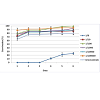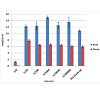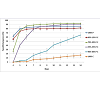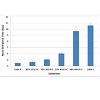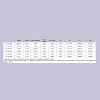Journal of Plant Biology & Soil Health
Download PDF
Research Article
Corresponding author: Nikos Tzortzakis, Department of Agricultural Science, Biotechnology and Food Science, Faculty of Geotechnical Sciences and Environmental Management, Cyprus University of Technology, PO BOX 50329, 3603, Limassol, Cyprus, Tel: +3570 25002280; E-mail: nikolaos.tzortzakis@cut.ac.cy
Citation: Chrysargyris A, Saridakis C, Tzortzakis N. Use of Municipal Solid Waste Compost as Growing Medium Component for Melon Seedlings Production. J Plant Biol Soil Health. 2013;1(2): 5.
Copyright © 2013 Chrysargyris A, et al. This is an open access article distributed under the Creative Commons Attribution License, which permits unrestricted use, distribution, and reproduction in any medium, provided the original work is properly cited.
Journal of Plant Biology & Soil Health | ISSN: 2331-8996 | Volume: 1, Issue: 2
Submission: 10 September 2013 | Accepted: 11 October 2013 | Published: 18 October 2013
Where: t = mean germination time, ti = given time interval, ni = number of germinated seeds during a given time interval, n = total number of germinated seeds.
Use of Municipal Solid Waste Compost as Growing Medium Component for Melon Seedlings Production (Hemiptera: Pentatomidae): Implications for Biological Pest Control
Antonios Chrysargyris1, Christos Saridakis1 and Nikos Tzortzakis1,2*
- 1Department of Organic Greenhouse Crops and Floriculture, School of Agricultural Technology, Technological Educational Institute of Crete, Heraklion, Greece
- 2Department of Agricultural Sciences, Biotechnology and Food Science, Cyprus University of Technology, Limassol, 3603 Cyprus
Corresponding author: Nikos Tzortzakis, Department of Agricultural Science, Biotechnology and Food Science, Faculty of Geotechnical Sciences and Environmental Management, Cyprus University of Technology, PO BOX 50329, 3603, Limassol, Cyprus, Tel: +3570 25002280; E-mail: nikolaos.tzortzakis@cut.ac.cy
Citation: Chrysargyris A, Saridakis C, Tzortzakis N. Use of Municipal Solid Waste Compost as Growing Medium Component for Melon Seedlings Production. J Plant Biol Soil Health. 2013;1(2): 5.
Copyright © 2013 Chrysargyris A, et al. This is an open access article distributed under the Creative Commons Attribution License, which permits unrestricted use, distribution, and reproduction in any medium, provided the original work is properly cited.
Journal of Plant Biology & Soil Health | ISSN: 2331-8996 | Volume: 1, Issue: 2
Submission: 10 September 2013 | Accepted: 11 October 2013 | Published: 18 October 2013
Abstract
The impacts of municipal solid waste compost (MSWC) in different contents were evaluated in melon (Citrulus melo L.) seed germination and seedling production in nurseries study. Extracts (10-0 up to 10-6 dilutions) of MSWC evaluated for seed priming/germination in Petri dishes. The MSWC extracts at 10-1-10-6 enhanced (up to 20%) seedling germination as well as shoot and root radicle length. However, pure extracts (at 10-0) delayed the seed germination for 3 days which was less than 25%. Under nursery conditions, six media [(% v/v): peat: MSWC (100:0) as control; peat:MSWC (85:15); peat: MSWC (70:30); peat:MSWC (55:45); peat:MSWC (40:60) and peat:MSWC (0:100)] were prepared from commercial peat and MSWC. Seedling growth/development parameters were assessed. Seed emergence enhanced when low MSWC content (< 30%) used while increased MSWC content (>60%) reduced (up to 80%) emergence and delayed up to 6 days the emergence time. Under nursery conditions, addition of MSWC (especially in content greater than 30%) reduced leaf numbers produced, seedling fresh weight (and dry matter content), chlorophyll a and total carotenoids content. Increased MSWC content into the substrate affected negatively the seedling height and leaf internal CO2 concentration. Stem diameter, leaf fluorescence and chlorophyll b content accelerated when 15-45% MSWC content used into the substrate. No significant differences observed in leaf stomatal conductance in plants grown in different MSWC contents. No visual phytotoxicity obtained macroscopically. Thus, low content (up to 30%) of MSWC may act as an alternative substitute of peat in melon seedling production.Keywords
Compost; Municipal Solid Waste; Peat; Growth; Fertigation; Melon; Seed EmergenceIntroduction
Transplants, compared with direct sowing, are a more reliable method of ensuring the proper establishment of a range of commercial horticultural crops with great economic value including vegetables. The production of vegetable seedlings, especial in Mediterranean countries with great field and greenhouse crops expansion, is a highly competitive business; uniform and rapid seed emergence is essential rerequisites to increase yield, quality, and profits in crops. Use of good crop substrates with appropriate physicochemical properties, is therefore critical [1].Under nursery conditions, peat is widely used as the main substrate component for production of seedlings in containers, and this is expanded in Southern Europe. However, peat is imported from Northern and Central Europe and recently has become more expensive and its properties more variable, which is due to material shortage as well as the environment disturbance through peat mining and processing. Thus, it is important to look for good quality and locally available low-cost peat substitutes. The need to recycle wastes and increasing environmental pressures against peat extraction leads to an increasing interest in the feasibility of substituting peat by organic wastes and by-products. A number of potential alternatives have been identified [2], and composts obtained from different organic materials have been proved to be promising [3]. However, the use of compost into substrates in different ratios may cause some problems as a consequence of its high salt content [4], unsuitable physical properties (water holding capacity, aeration etc.), heavy metal toxicity [5,6] and variable quality and composition [7].
The appropriate amount of composts added in growth medium needs to be determined to improve plant growth [8-9]. In some cases, mixtures of compost with per liter may be used as substrates without the need for additional mineral fertilizer [4,10], as the necessary nutrient amount is provided by the compost itself.
The present study examined the impacts of the MSWC mixed with conventional peat substrates at various ratios, as a growth medium in the nursery production of melon.
Materials and Methods
Seed and municipal solid waste compost sourceSeeds of melon (Citrulus melo L. cv Ananas) were purchased from Agrospito company (Goldsmith seeds Ltd, CA, USA). The municipal solid waste compost was purchased from Inter-Municipal Enterprise for the Management of Solid Wastes (IMEMSW), based in Chania, Greece. The compost used was made from the organic fraction of selectively-collected urban waste while the composting procedure lasted for 5-6 months, and the organic fraction were regularly turned and watered, following standard composting procedures. Sixty percent of the compost consisted of particles with < 4mm size. The main physicochemical characteristics (in dry weight: dwt) of the compost had been described previously [13]. In details characteristics of compost were pH: 7.7; electrical conductivity (EC): 17.9 dS m-1 (1:1 v/v); ashes: 50.1% dwt; organic matter: 49.9% dwt; organic Carbon:27.2% dwt; N: 1.9% dwt; ratio C/N: 7.1; P: 164 μg g-1; K: 727 μg g-1; Na:403 μg g-1, under low limits for heavy metal content.
MSWC Extracts and Germination Studies in vitro
Municipal solid waste compost extracts obtained by using a 2-L capacity plastic container which was filled with MSWC:water (1:1.5) and was shaking for 24 h at room temperature. The EC and pH of MSWC extract were evaluated with a portable EC/pH-meter. The MSWC extract was diluted in the ratios of 1:0, 1:10, 1:100, 1:1000, 1:10000, 1:100000 (MSWC:water at 10-0 up to 10-6 dilutions). For germination tests, air-dried melon seeds were placed in Petri dishes with filter paper (four replicates/treatment, 25 seeds/replicate) in a completely randomized design under laboratory conditions (average temperatures: 24.1±2.3°C max, 21.5±2.8°C min) and monitored daily. Filter papers were moistened daily using aliquots of diluted MSWC extract for the six treatments. Control treatments (Plates) were moisturised with dH2O. Seeds were considered germinated upon radicle emergence. Mean shoot and root length was evaluated on the sixth day.
Germination and Plant Growth Studies in Nursery Tests
A mix of commercial peat (P-Professional peat, Gebr. Brill Substrate GmbH & Co.KG, Georgsdorf, Germany), Perlite (Perloflor, Protectivo EPE, Athens, Greece) and MSWC were used to create six treatments which were (% v/v): 1) peat:MSWC (100:0) as control, 2) peat:MSWC (85:15), 3) peat:MSWC (70:30), 4) peat:MSWC (55:45), 5) peat:MSWC (40:60) and 6) peat:MSWC (0:100). In each substrate medium 10% (v/v) of Perlite was added for adequate substrate aeration.Seeds of melon were sown (5 seeds per well; 4 wells per replication; 5 replications per treatment, 40 cm3 well capacity) in black plastic seedling trays and watering by mist through a timer and according to seedling needs. The experiment was carried out in a completely randomized design in an unheated glasshouse with a north-south orientation at the School of Agricultural Technology at Heraklion, Greece. Seed germination was daily recorded. Twelve days after seeding, seedlings were thinned to single plant, maintaining 4-5cm distance among seedlings. Mean germination time (MGT) was calculated as follows, according to Labouriau [17]:

Where: t = mean germination time, ti = given time interval, ni = number of germinated seeds during a given time interval, n = total number of germinated seeds.
After 31 days, seedling growth was assessed by harvesting six individuals/treatment. Seedlings were harvested above substrate, the leaf number and height (cm) per seedling, measured from substrate surface, stem diameter (mm) measured below the cotyledon node, upper fresh weight (g), total dry matter (%), content (μg/g fresh weight) of chlorophyll a (Chla), chlorophyll b (Chlb) and total carotenoids (Car) determined according to Porra [18]. Leaf fluoresces determined (chlorophyll fluorometer, opti-sciences ΟS-30p, UK) and leaf photosynthetic rate (pn), the stomatal conductance (gs) and the internal leaf concentration of CO2 (Ci) measured using a portable infra-red gas analyser (model Li-6200, Li-Cor, Inc., Lincoln, Nebr.). Measurements were carried out between 9:00-11:10 AM, the leaf temperature within the chamber was (28 ± 2)°C, photosynthetic photon flux density of 1300 μmol/m2/s at the ambient CO2 concentration. The Li 6200 was equipped with a leaf chamber with constant area inserts (6.0 cm2). All gas-exchange measurements started 3 h after the onset of the photoperiod and were replicated in nine plants of each treatment and on two fully expanded, healthy, sun-exposed leaves per plant.Leaf elemental analysis for potassium-K, phosphorus-P, sodium- Na and nitrogen-N was determined at the end of the experiments. After a hydrochloric digestion of the plant sample ash, nutrients analysis for K and Na (photometric; JENWAY, PEP-7 Jenway, Dunmow, UK), P (spectrophotometric; Pye Unicam Hitachi U-1100, Tokyo, Japan) was determined while total N determined through Kjeldahl method.
Statistical Analysis
The experiment was carried out twice. Percentage data were logtransformed before analysis. Data were tested for normality, and then subjected to analysis of variance (ANOVA). Significant differences between mean values were determined using Least Significant Difference (LSD) following one-way ANOVA. Statistical analyses were performed using SPSS (SPSS Inc., Chicago, Ill.).Results and Discussion
Seed Germination and Emergence Time in vitroThe first germination was observed after one day after seeding while the final germination was obtained before six days. The municipal solid waste compost extract at 10-1-10-6 concentrations increased seed germination comparing with the control treatment (water) with significant differences marked at 10-2-10-6 concentrations (Figure 1). However, when pure (10-0 concentration) extract used, seed germination was delayed (up to 3 days) and reduced up to 69% compared with control treatment, and this may be attributed to high EC and pH values of MSWC extract (1:1.5 v/v; EC: 11.21 dS m-1; pH: 6.87), being in agreement with relevant studies contacted with MSWC in marigold and basil seedling production [13]. In previous studies, it was reported that there was no inhibition of germination in case of cucumber seeds in relation to the control treatment when MSWC:water extracts used [19]. The MSWC extract increased shoot length at concentrations of 10-1 and root radicle length at concentrations of 10-1-10-6 of germinated seeds comparing with the water treatment, while the pure MSWC extract inhibited germination (Figure 2). Similar findings observed in previous studies when olive-mill wastes extracts used for seed priming procedure in lettuce and radish [20]. Moreover, severe reduction in root length and shoot length were observed for the cucumber seeds treated with 1:7.5 MSWC:water extracts [19]. The stimulatory effects due to the MSWC extract on seed germination may help early seed germination, providing a higher competitive ability [21] and reducing losses in seed germination.
Seed germination and emergence time in vivo
The first seed emergence observed at four days after sowing (Figure 3). When the MSWC amount increased into the substrate it delayed the emergence tine and reduced seed emergence percentage initially, but there were no differences after 8 days and so on. Seed emergence was reduced up to 24% and 80% when 60% and 100% of the MSWC were added, respectively and this is possible due to the fact that the MSWC provided nutrients as organic material and increased EC values (see Figure 1). Indeed, no differences were observed in seed emergence when < 30% MSWC was used. Moreover, increasing the MSWC content into the substrate resulted in MET delayed (up to 6 days) (Figure 4) which is in accordance with previous studies employing MSWC in marigold seeds emergence [14]. Seedling growth in vivo
Figure 3: Impact of municipal solid waste compost (C) in different ratios with commercial peat (P) on cumulative seedling emergence of melon seeds germinated in greenhouse nursery. Values represent mean (± SE) of measurements made on 5 independent replication (4 wells per replication; 5 seeds per well) per treatment.
Figure 4: Impact of municipal solid waste compost (C) in different ratio with commercial peat (P) in mean emergence time for melon seeds germinated in greenhouse nursery. Values represent mean (± SE) of measurements made on 5 independent replication (4 wells per replication; 5 seeds per well) per treatment.
Substrate with different mixtures of MSWC and peat (P) affected some characteristics of plant growth and yield. Analyses of variance indicated that addition of MSWC in peat significantly reduced seedling height (between 34% and 87%) and dry matter content (between 34% and 100%) (Table 1) which are in agreement with previous studies in cucumber seedlings [15]. Seedling resistance to transplant stress is directly related to dry matter content, which improves seedling establishment in the soil or growth substrate [22]. Leaf number and seedling fresh weight reduced in MSWC content ≥ 30% while no differences observed between control [P:MSWC (100:0%)] and P:MSWC (85:15%). MSWC add of 15-45% into peat accelerated (up to 36%) stem diameter while MSWC content greater than 60% reduced significantly the stem diameter comparing with the control (see Table 1).The increase MSWC content (between 15% and 60%) into the substrate resulted in increased K and Na content of seedlings biomass providing nutritive value for the examined substrates but decreased P content for P:MSWC (55:45%) and P:MSWC (40:60%). Nitrogen content did not change among the different MSWC contents with exception the P:MSWC (85:15%) which marked an increased value, comparing with the control. It’s worthwhile to mention that seedlings in 100% MSWC did not survive (grown) as a consequence this treatment was not possible to be analysed further.Leaf fluoresces increased in seedlings grown in P:MSWC (85:15%) and P:MSWC (70:30%) (see Table 2). The content of Chla and total carotenoids decreased in P:MSWC (70:30%) and P:MSWC (55:45%) comparing with the control while the leaf photosynthetic rate and Chlb content increased in case of P:MSWC (70:30%) possible due to the better physiological status of plant development and/or improved media physicochemical properties. The addition of MSWC into the substrate reduced leaf internal concentration of CO2. No major differences were observed in leaf stomatal conductance among treatments.The rapid and uniform seed emergence is an essential prerequisite to increase yield, quality, and profit. Slow emergence results in smaller plants and seedlings, which are more vulnerable to soil-borne diseases while extended emergence periods predispose the planting bed to deterioration and increased soil compaction, particularly under adverse environmental conditions [23]. Although there is no single, ideal growth medium for nursery-produced horticultural crops [24], most greenhouse-grown species display better growth at slight acid pH values (5.2-7.0); peat mixtures approached these values but MSWC did not. Like pH levels, the highest initial substrate EC values were recorded for mixtures containing MSWC. Ribeiro and e Santos [25] reported that substrates with high EC values reduced water retention, negatively affecting the imbibing process and may delay seed emergence rates.Thus, seedlings grown in the MSWC mixtures in high content displayed worse plant development and suitability for seedling production, possible due to increased EC and/or alternated mediumphysicochemical properties. Low content (up to 30%) of MSWC may act as an alternative substitute of peat for melon seedling production, while additional fertigation may need to be examined in future study.
Table 1: Impact of municipal solid waste compost (C) in different ratio with commercial peat (P) on seedling height (cm/plant), number of leaf produced, stem diameter (mm), fresh weight (g/plant), dry matter content (%) and on leaf elemental (potassium-K, phosphorus-P, sodium-Na, nitrogen-N) concentration (mg/g fresh weight) on melon plant grown in nursery.Yvalues (n=6) in columns followed by the same letter are not significantly different, P≤0.05.Zvalues represent measurements made on 3 replication (3 seedlings mixed per replication) per treatment] in columns followed by the same letter are not significantly different, P≤0.05.
Table 2: Impact of municipal solid waste compost (MSWC) in different ratio with commercial peat (CP) on leaf fluoresces (Fv/Fm), Chlorophyll a (Chla; μg/g fw), Chlorophyll b (Chlb; μg/g fw), total carotenoids (Car; μg/g fw), leaf photosynthetic rate (Pn: μmol m-2 s-1), leaf stomatal conductance (gs: μmol m-2 s-1) and leaf internal CO2 concentration (ci: μmol mol-1) on melon plant grown in nursery.Yvalues (n=6) in columns followed by the same letter are not significantly different, P≤0.05.
Acknowledgements
This work was funded by the Greek National Research program XM EOX: EL0031.References
- Sterrett SB (2001) Compost as horticultural substrates for vegetable transplant production. In: Stoffella PJ, Kahn BA (Eds.), Compost Utilization in Horticultural Cropping Systems, Lewis Publication, Boca Raton, FL, 227-240.
- Abad M, Noguera P, Bures S (2001) National inventory of organic wastes for use as growing media for ornamental potted plant production: case study in Spain. Bioresour Technol 77: 197-200.
- Sanchez-Monedero MA, Roig A, Cegarra J, Bernal MP, Noguera P et al. (2004) Composts as media constituents for vegetable transplant production. Compost Sci Util 12: 161-168.
- Castillo JE, Herrera F, López-Bellido RJ, López-Bellido FJ, López-Bellido L. et al. (2004) Municipal solid waste (MSW) compost as a tomato transplant medium. Compost Sci Util 12: 86-92.
- Vavrina CS (1995) Municipal solid waste materials as soilless media for tomato transplant. Proceedings of the Florida State Horticultural Society 108: 232-234.
- Spiers TM, Fietje G (2000) Green waste compost as a component in soilless growing media. Compost Sci Util 8: 19-23.
- Hicklenton PR, Rodd V, Warman PR (2001) The effectiveness and consistency of source-separated municipal solid waste and bark composts as components of container growing media. Sci Horticult 91: 349-363.
- Siminis HI, Manios VL (1990) Mixing peat with MSW compost. Biocycle 11: 60-61.
- Ribeiro HM, Romero AM, Pereira H, Borges P, Cabral F et al. (2007) Evaluation of a compost obtained from forestry wastes and solid phase of pig slurry as a substrate for seedlings production. Bioresource Technol 98: 3294-3297
- Kostov O, Tzvetkov Y, Kaloianova N, Van Cleemut O (1996) Production of tomato seedlings on composts of vine branches and grape pruning’s, hunks and seeds. Compost Sci Util 4: 55-61.
- McConnell DB, Shiralipour A, Smith W (1993) Compost application improves soil properties. Biocycle 34: 61-63.
- Tzortzakis N, Gouma S, Dagianta E, Saridakis C, Papamichalaki M et al. (2012) Use of fertigation and municipal solid waste compost for greenhouse pepper cultivation. ScientificWorldJournal 2012: 973193.
- Tzortzakis N, Gouma S, Paterakis C, Manios T (2012) Deployment of municipal solid wastes as a substitute growing medium component in marigold and basil seedlings production. ScientificWorldJournal 2012: 285874.
- Herrera F, Castillo JE, Chica AF, López Bellido L (2008) Use of municipal solid waste compost (MSWC) as a growing medium in the nursery production of tomato plants. Bioresource Technol 99: 287-296.
- Mami Y, Peyvast G (2010) Substitution of municipal solid waste compost for peat in cucumber transplant production. J Hort Forestry 2: 157-160.
- Fitzpatrick GE, Duke ER, Klock-Moore KA (1998) Use of compost products for ornamental crop production: research and grower experiences. HortScience 33: 941-944.
- Labouriau LG (1983) Seed germination. Organization of American, Washington. 174 pp.
- Porra RJ (2002) The chequered history of the development and use of simultaneous equations for the accurate determination of chlorophylls a and b. Photosynthesis Res 73: 149-156.
- Pal R, Bhattacharyya P (2003) Effect of municipal solid waste compost on seed germination of rice, wheat and cucumber. Arch Agron Soil Sci 49: 407-414.
- Kelepesi S, Tzortzakis NG (2009) Olive-mill wastes - A growing medium component for seedling and crop production of lettuce and chicory. Int J Veg Sci 15: 325-339..
- Zhang J, Maun MA (1990) Seed size variation and its effects on seedling growth in Agropyron psammophilum. Botl Gaz 151: 106-113.
- Pimpini F, Gianquinto G (1991) Primi resultati sulle modalita di allevamento invivaio di piantina di pomodoro da industria. Riflessi su aecrescimento e produzione in campo. 2 Convego Nazionale “Il vivaismo Octicolo”. Foggia.
- Cantliffe DJ (2003) Seed enhancements. Acta Hort 607: 53-59.
- Bugbee GJ (1996) Growth of Rhododendron, Rudbeckia and Thujia and the leaching of nitrates as affected by the pH of potting media amended with biosolids compost. Compost Sci Util 4: 53-59.
- Ribeiro HMF, e Santos JQ (1997) Utiliçao de residuos sólidos urbanos comportados na formulaçao de sustratos: Efeito nas propiedades físicase químicas dos sustrato. Actas de Horticultura. Vol. 18-II. Congreso Iberoamericano e III Congreso Ibérico de Ciencias Hortícolas. 11–15 Março, 1997, Vilamoura, Portugal..


